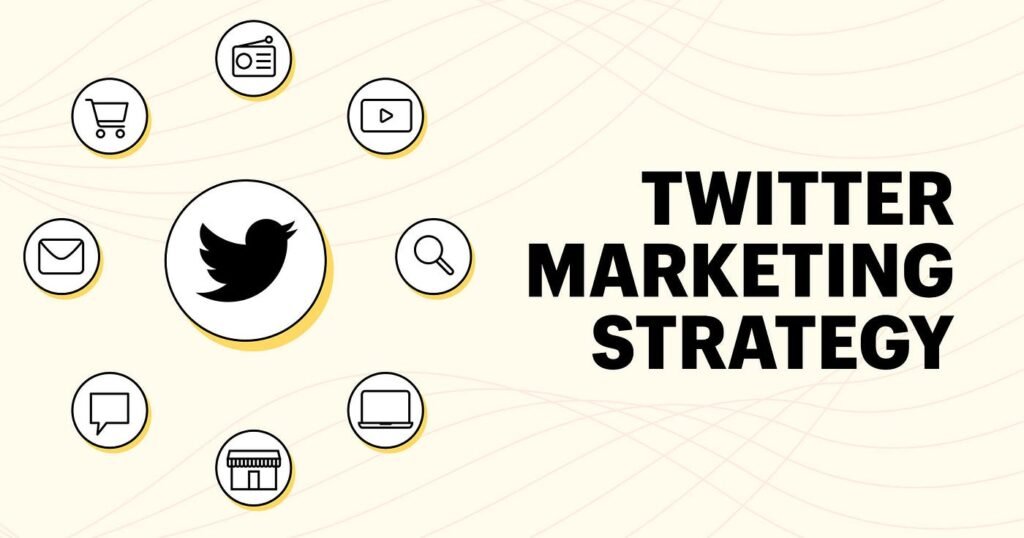What is Twitter Marketing?
Twitter marketing involves leveraging the social media platform Twitter as a means to promote products, services, brands, or individuals. This strategy revolves around the creation and dissemination of content on Twitter with the goal of engaging users and achieving specific marketing objectives. Twitter, being a microblogging platform, allows users to share concise messages known as tweets with their followers.
A critical aspect of Twitter marketing is the optimization of a user’s profile. This includes creating a well-optimized Twitter profile featuring a recognizable profile picture, a compelling bio, and relevant links to websites or landing pages. The profile serves as the first impression for potential followers, making it crucial for conveying key information about the brand or individual.
Content creation is another fundamental component of Twitter marketing. This involves developing and sharing various types of content, such as text-based tweets, images, videos, GIFs, and links to articles or websites. The diversity in content helps maintain audience interest and cater to different preferences within the Twitter community.
Engagement with the audience is a cornerstone of effective Twitter marketing. This includes activities like responding to mentions, retweeting relevant content, and actively participating in conversations within the Twitter community. By fostering meaningful interactions, brands and individuals can build a loyal and engaged following.
The use of hashtags is a prevalent strategy in Twitter marketing. Hashtags are employed to categorize and discover content, increase visibility, and participate in trending topics. Strategic use of relevant hashtags can significantly enhance the reach of tweets and contribute to overall brand visibility.
Twitter Ads, the platform’s advertising feature, plays a vital role in Twitter marketing. Through this feature, marketers can promote tweets, accounts, or trends to a broader audience, allowing for targeted and measurable campaigns.
Monitoring and analyzing performance metrics are essential for refining Twitter marketing strategies. Twitter Analytics provides insights into the reach, engagement, and impact of tweets, enabling marketers to make data-driven decisions and optimize their approach over time.
In addition to these strategies, various tactics such as Twitter chats, collaborations, contests, live tweeting, branded hashtags, and Twitter Moments contribute to a comprehensive Twitter marketing strategy. When executed strategically and consistently, Twitter marketing can be a powerful tool for building brand awareness, driving website traffic, engaging with the target audience, and promoting products or services.
Benefits of X/twitter marketing
Twitter marketing offers a range of benefits for individuals, businesses, and brands looking to enhance their online presence and achieve specific marketing goals. Here are some key benefits of Twitter marketing:
Brand Visibility and Awareness:
- Twitter provides a platform for brands to increase their visibility and raise awareness. Regularly sharing content and engaging with followers helps establish a recognizable presence in the Twitter community.
Real-time Engagement:
- The fast-paced nature of Twitter allows for real-time engagement with the audience. Brands can respond quickly to industry trends, news, and customer inquiries, fostering a sense of immediacy and connection.
Audience Interaction and Feedback:
- Twitter facilitates direct interaction with the audience through mentions, replies, and retweets. This engagement allows brands to gather valuable feedback, address customer concerns, and build stronger relationships with their audience.
Website Traffic Generation:
- By sharing links to blog posts, articles, or product pages, Twitter can drive traffic to a brand’s website. Strategic use of calls-to-action in tweets can encourage followers to click through and explore additional content.
Hashtag Campaigns and Trends:
- Brands can create and participate in hashtag campaigns to promote specific messages, events, or product launches. This not only increases visibility but also encourages user-generated content and participation.
Community Building:
- Twitter allows brands to build communities around their products or services. Engaging in conversations, participating in Twitter chats, and fostering a sense of community helps strengthen brand loyalty.
Influencer Partnerships:
- Twitter is a platform where influencers and thought leaders often share their insights and recommendations. Brands can leverage influencer partnerships to expand their reach, tap into new audiences, and benefit from the credibility of influencers.
Customer Service and Support:
- Many users turn to Twitter to seek customer support. Brands can use the platform to address customer queries, provide assistance, and showcase their commitment to customer satisfaction in a transparent manner.
Twitter Ads for Targeted Marketing:
- The Twitter Ads platform allows brands to run targeted campaigns, reaching specific demographics, interests, and locations. This targeted approach ensures that marketing efforts are directed toward the most relevant audience.
Analytics for Performance Evaluation:
Twitter Analytics provides insights into the performance of tweets, audience demographics, and engagement metrics. Marketers can use this data to evaluate the effectiveness of their Twitter marketing strategies and make informed adjustments.
Global Reach:
Twitter’s global user base enables brands to reach audiences around the world. This can be particularly advantageous for businesses looking to expand their reach internationally.
Competitive Advantage:
Actively engaging on Twitter and staying current with industry trends can provide a competitive advantage. Brands that establish themselves as industry leaders on Twitter may be more likely to attract attention and trust from their target audience.
By leveraging these benefits, businesses, and individuals can effectively use Twitter as a powerful marketing tool to achieve their objectives and stay competitive in the digital landscape.
How to create a Twitter content strategy?
Creating a successful Twitter content strategy involves careful planning, understanding your audience, and aligning your content with your overall marketing goals. Here’s a step-by-step guide to help you develop an effective Twitter content strategy:
1. Define Your Objectives:
- Clearly outline your goals for using Twitter. These could include increasing brand awareness, driving website traffic, generating leads, or engaging with your audience. Your content strategy should align with these objectives.
2. Understand Your Audience:
- Conduct audience research to understand the demographics, interests, and behaviors of your target audience. Identify the type of content they find valuable and engaging.
3. Competitor Analysis:
- Analyze the Twitter accounts of your competitors to identify what types of content resonate with their audience. This can help you differentiate your content strategy and find unique angles.
4. Brand Voice and Persona:
- Define your brand voice on Twitter. Consider the tone, language, and personality that align with your brand. This consistency helps in building brand identity.
5. Content Categories:
- Determine the types of content you will share on Twitter. This could include product updates, industry news, behind-the-scenes content, user-generated content, and more. Create a mix to keep your feed diverse and engaging.
6. Content Calendar:
- Develop a content calendar outlining when and what you will post. This helps maintain consistency and ensures that your content aligns with important dates, events, or campaigns.
7. Hashtag Strategy:
- Develop a hashtag strategy to increase the discoverability of your tweets. Create branded hashtags, participate in trending hashtags, and use relevant industry or community hashtags.
8. Visual Content:
- Incorporate visual elements into your tweets. Use images, videos, GIFs, and infographics to make your content more visually appealing and shareable.
9. Engagement Tactics:
- Plan how you will engage with your audience. This includes responding to comments, retweeting mentions, participating in Twitter chats, and asking questions to encourage interaction.
10. Promotional Content:
Integrate promotional content strategically. Avoid being too sales-oriented; instead, focus on providing value and solving problems for your audience.
11. Content Repurposing:
Repurpose content from other channels to maximize its reach. Tailor content for Twitter’s shorter format while maintaining consistency with your overall messaging.
12. Twitter Ads:
Consider incorporating Twitter Ads into your strategy for targeted promotions. This can help amplify your reach and engage with a broader audience.
13. Measure and Analyze:
Regularly analyze the performance of your tweets using Twitter Analytics. Evaluate metrics such as engagement, reach, click-through rates, and follower growth. Use this data to refine and optimize your strategy.
14. Adapt and Iterate:
Stay flexible and be willing to adapt your strategy based on the evolving preferences of your audience and changes in the Twitter landscape. Regularly iterate and refine your approach.
15. Monitor Trends and News:
Stay informed about industry trends and news. Participate in relevant conversations and share timely content to demonstrate your brand’s relevance and expertise.
By following these steps and continuously refining your approach based on performance insights, you can develop a robust Twitter content strategy that aligns with your business objectives and effectively engages your target audience.
Twitter marketing tips to influence your strategy
Influencing your Twitter marketing strategy involves incorporating tips and best practices that can enhance your reach, engagement, and overall impact on the platform. Here are some Twitter marketing tips to influence your strategy:
1. Leverage Twitter Analytics:
- Regularly analyze Twitter Analytics to gain insights into your audience, top-performing tweets, and overall engagement. Use these insights to refine your content strategy.
2. Optimize Your Profile for Search:
- Use relevant keywords in your Twitter bio and handle to make your profile more discoverable in search results.
3. Use Compelling Visuals:
- Incorporate eye-catching images, videos, and GIFs into your tweets to increase visibility and engagement. Visual content tends to grab attention more effectively.
4. Tweet Consistently:
- Maintain a consistent posting schedule to keep your audience engaged. Consistency helps build anticipation and keeps your brand on top of your mind.
5. Participate in Twitter Chats:
- Engage with your community by participating in relevant Twitter chats. This not only increases your visibility but also establishes your brand as an active participant in industry conversations.
6. Craft Engaging Tweets:
- Create tweets that encourage interaction, such as asking questions, running polls, or using call-to-action phrases. Engagement is key to a successful Twitter strategy.
7. Build Relationships with Influencers:
- Identify and engage with influencers in your industry. Building relationships with influencers can expand your reach and lend credibility to your brand.
8. Utilize Twitter Lists:
- Create and subscribe to Twitter Lists to organize and monitor conversations within your industry. This helps you stay informed and engage with relevant content.
9. Run Twitter Polls:
- Use Twitter Polls to gather opinions from your audience. Polls are not only engaging but also provide valuable insights into your followers’ preferences.
10. Responsive Customer Service:
Prioritize responsiveness in handling customer inquiries and feedback on Twitter. Timely and positive interactions contribute to a positive brand image.
11. Experiment with Twitter Spaces:
Take advantage of Twitter Spaces, the platform’s audio feature, to host live conversations and engage with your audience in a more dynamic way.
12. Strategic Use of Hashtags:
Use hashtags strategically to increase the discoverability of your tweets. Create branded hashtags and participate in trending ones to amplify your reach.
13. Create Twitter Moments:
– Compile important tweets and events into Twitter Moments. This feature allows you to curate and showcase content around specific themes or campaigns.
14. Run Contests and Giveaways:
Boost engagement and expand your reach by running contests or giveaways. Encourage participants to retweet, follow, or use specific hashtags for entry.
15. Monitor Competitor Activity:
Keep an eye on your competitors’ Twitter activities. Identify successful strategies and learn from their approaches, but also look for gaps where you can differentiate your brand.
16. Optimize Posting Times:
Experiment with different posting times to identify when your audience is most active. Optimize your schedule to maximize visibility and engagement.
17. Share User-Generated Content:
Encourage your followers to create and share content related to your brand. User-generated content can be a powerful tool for building community and authenticity.
18. A/B Test Your Tweets:
Experiment with different tweet formats, tones, and styles. A/B testing helps you identify what resonates best with your audience.
19. Geo-Targeted Content:
Tailor your content to specific regions or locations, especially if your business has a local or regional focus. This can make your tweets more relevant to a targeted audience.
20. Stay Informed and Adaptive:
Keep up with Twitter updates, algorithm changes, and emerging trends. Adapt your strategy to align with the evolving nature of the platform.
Conclusion:
Incorporating these Twitter marketing tactics into your overall digital strategy can lead to increased brand visibility, engagement, and ultimately, business growth. By leveraging the unique features of Twitter and staying consistent with your brand message, you can establish a strong online presence and connect with your target audience effectively.




